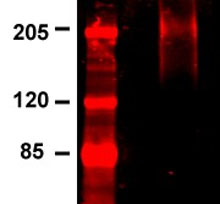Protocol: Immunoprecipitation


Application Notes:
Immunoprecipitation is a procedure by which proteins or peptides that react specifically with an antibody are removed from solution and examined for quantity or physical characteristics. Immunoprecipitation can also be used to “enrich” a protein population prior to Western blotting. For example, immunoprecipitation with a pan-specific antibody against a protein of interest followed by Western blotting with a modification-specific antibody (such as a phospho-specific antibody or an acetylation-specific antibody).
Solutions and Reagents:
20 mM Tris-HCl, pH 7.5 1 µg/ml aprotinin
1 µg/ml leupeptin 3 mM Na4P2O4
Protein A/G sepharose:
Transfer 30 µl protein A or G sepharose per sample in a microcentrifuge tube,
wash twice in cell lysis buffer to remove preservative (add cell lysis buffer up
to 800 µl and spin down in benchtop centrifuge). Resuspend protein A or G
sepharose in cell lysis buffer at 100 µl per sample.
5X SDS sample Buffer:
312.5 mM Tris-HCl (pH 6.8)
10% SDS (w/v)
250 mM DTT
50% Glycerol
0.05% Bromophenol Blue (w/v)
Use at 1X
10X SDS Running Buffer:
distilled H2O.
Add distilled H2O to 1 liter
Use at 1X
Transfer Buffer:
2.25 g Tris base
10.5 g Glycine
1 g SDS
200 ml Methanol
Add distilled water to 1.0 L
Sample preparation:
1. Collect cells and transfer to a microcentrifuge tube and centrifuge at 3000
rpm for 5 min at 4°C.
2. Discard the supernatant and store the pellet at -80°C or process immediately
as described below.
Immunoprecipitation:
1. Remove samples from -80°C freezer and place on ice.
2. Immediately add 800 µl ice-cold lysis buffer to the samples and vortex, then
incubate for 30 min on ice.
3. Spin lysates at 14,000 rpm in a pre-cooled centrifuge for 10 min.
4. Transfer 720 µl supernatant to a fresh pre-cooled microcentrifuge tube containing
washed protein A or G agarose bead slurry (30 µl packed beads) and
rock the mixture for 30 min at 4°C. Collect the agarose beads by pulsing in a
microcentrifuge (5 seconds at 14,000 rpm, 4°C).
5. Remove supernatant and place in a fresh pre-cooled microcentrifuge tube
containing ~4 µg specific antibody and rock gently at 4°C for 2 hrs. Capture
the immune complex by adding 100 µl of washed protein A or G agarose
bead slurry (30 µl packed beads) and rock the mixture for 1 hr at 4°C.
6. Collect the agarose beads by pulsing in a microcentrifuge (5 seconds at
14,000 rpm, 4°C). Aspirate and discard supernatant. Wash the beads 3 times
with ice-cold cell lysis buffer.
7. After final wash, remove supernatant and add 40 µl 2X SDS sample buffer.
Boil for 5 min at 95°C and spin down the beads at maximum speed
in a microcentrifuge for 5 min at room temperature. Carefully pipette off
supernatant.
8. Load up 30 µl of sample in each well of a 1.5 mm thick gel. Run gel according
to manufacturer’s recommendations and continue with immunoblotting
using BioLegend’s Western Blotting protocol, p. 31 (alternately, radiolabeled proteins prepared from target cells can be used to directly visualize the
immunoprecipitated protein).
Tips:
1. The choice of lysis buffer depends on the location of the protein (membrane,
cytosolic, nuclear).
2. Immunoprecipitates allowed to incubate overnight may have a higher
background than ones processed for shorter periods of time due to timedependent
aggregation or denaturation of cellular proteins.
3. Always use an isotype-matched irrelevant control antibody (monoclonal) or
same-species serum from a non-immunized animal to remove non-specific
antibody binding in cellular lysates.
